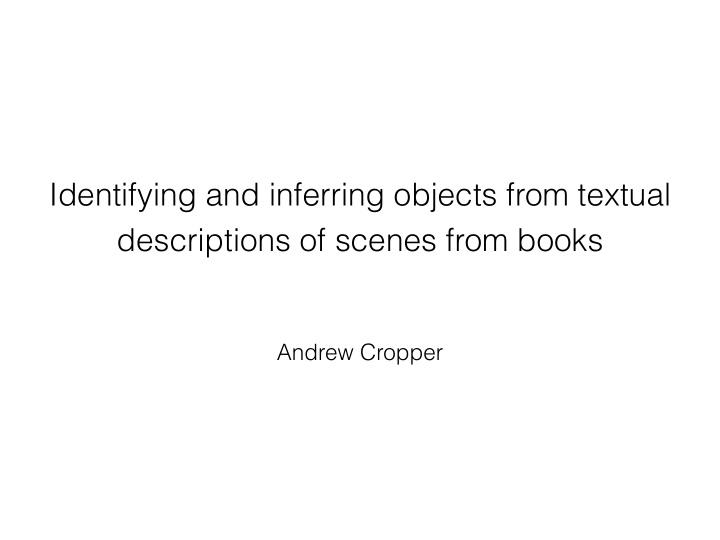



Identifying and inferring objects from textual descriptions of scenes from books � � Andrew Cropper
Outline • Text-to-scene conversion (TTSC) • TTSC from books • WordNet • Implementation • Experiments • Conclusions and future work
Text-to-scene conversion “The lawn mower is 5 feet tall. John pushes the lawn mower. The cat is 5 feet behind John. The cat is 10 feet tall.”
Text-to-scene conversion “The lawn mower is 5 feet tall. John pushes the lawn mower. The cat is 5 feet behind John. The cat is 10 feet tall.”
TTSC from books “I was going to email Van and Jolu to tell them about the hassles with the cops, but as I put my fingers to the keyboard, I stopped again.”
TTSC from books ? “I was going to email Van and Jolu to tell them about the hassles with the cops, but as I put my fingers to the keyboard, I stopped again.”
TTSC from books words reader scene
TTSC from books words ? scene
TTSC from books words POS tagging scene
POS tagging “She placed the pen on the desk” � �
POS tagging “She placed the pen on the desk” � � she/PRP placed/VBD the/DT pen/NN on/IN the/DT desk/NN
POS tagging “She placed the pen on the desk”
POS tagging limitations “Whilst talking about the weather, she placed the pen on the desk” � �
POS tagging limitations “Whilst talking about the weather, she placed the pen on the desk” � � whilst/IN talking/VBG about/IN the/DT weather/NN ,/, she/PRP put/VBD the/DT pen/NN on/IN the/DT table/NN
TTSC from books POS tagging words + scene Wordnet
Wordnet
Wordnet 45 logical categories, including: � • noun.person: denoting people • noun.location: denoting spatial position • noun.communication: denoting communicative processes and contents • noun.artifact: denoting man-made objects
Wordnet “Whilst talking about the weather, she placed the pen on the desk” � <noun.phenomenon>S: (n) weather , weather condition, conditions, atmospheric condition (the atmospheric conditions that comprise the state of the atmosphere in terms of temperature and wind and clouds and precipitation) � < noun.artifact >S: (n) pen (a writing implement with a point from which ink flows) � < noun.artifact >S: (n) table (a piece of furniture having a smooth flat top that is usually supported by one or more vertical legs)
WordNet limitations (why we need POS + WordNet) noun.artifact in Wordnet “The politician wishes to table an amendment to the proposal” � The/DT politician/NN wishes/VBZ to/TO table/VB an/DT amendment/NN to/TO the/DT proposal/NN
TTSC from books - what we have “She placed the pen on the desk”
TTSC from books - what we want “She placed the pen on the desk”
Automatic TTSC from books POS tagging + words Wordnet scene + Wikipedia
Wikipedia
Wikipedia
Implementation notes • Python + Natural Language Toolkit • Wikipedia export pages • Tokenising, POS tagging, singularise plurals, aggregate synonyms • Identify objects by the noun.artifact category • Look at the corresponding Wikipedia page for each potential object in a scene. • Rank objects by tfidf
Experiments anachronism , noun � � a thing belonging or appropriate to a period other than that in which it exists, especially a thing that is conspicuously old-fashioned: the town is a throwback to medieval times, an anachronism that has survived the passing years.
Experiments Corey Doctorow’s Little Brother, manually parsed
Objects identified good : bed, computer, picture, telephone, projector, screen, microscope, bag, keyboard � bad : room, ceiling, wall � ugly : jail, camp, room, filter, radar
Objects missed “I hooked up my Xbox as soon as I got to my room” Not in Wordnet
Objects inferred
Conclusions • Use Wikipedia and WordNet to identify explicit objects and infer implicit objects from scenes from a book • Able to infer implicit objects such as keyboard and screen by identifying explicit objects such as computer � Future work • Better weighting scheme • Use more sophisticated NLP techniques, such as using word-sense disambiguation
References Terry Winograd. Procedures as a representation for data in a computer program for understanding natural language. Technical report, DTIC Document, 1971. � Bob Coyne and Richard Sproat. Wordseye: an automatic text-to-scene conversion sys- tem. In Proceedings of the 28th annual conference on Computer graphics and interactive techniques, pages 487–496. ACM, 2001. � Richard Sproat. Inferring the environment in a text-to-scene conversion system. In Proceedings of the 1st international conference on Knowledge capture, pages 147–154. ACM, 2001. � George A Miller. Wordnet: a lexical database for english. Communications of the ACM, 38(11):39–41, 1995. � Angel X Chang, Manolis Savva, and Christopher D Manning. Semantic parsing for text to 3d scene generation. ACL 2014, page 17, 2014.
Thank you
Recommend
More recommend